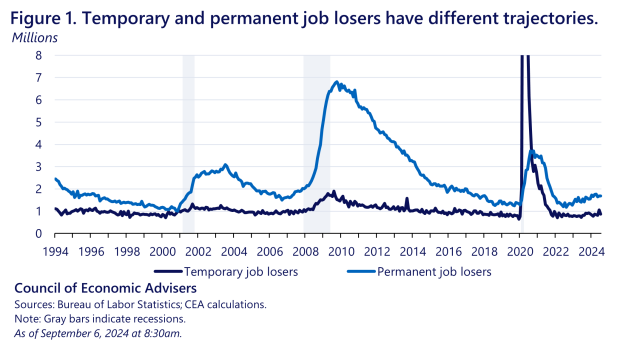The Unemployment Rate in Context
Payroll employment rose 142,000 last month, and the unemployment rate ticked down from 4.3 to 4.2 percent. Though hiring has slowed—average payroll gains over the past three months were 116,000—the U.S. job market continues to generate solid job gains and wage growth that is consistently beating inflation.
For more details on today’s report, see CEA’s X thread.
At 4.2% the unemployment rate, while still low, is up half-a-point from the beginning of the year. What’s behind this increase? There is no single, simple answer, but one factor behind the July increase was so-called temporary unemployment. The dynamics of unemployment over the past two months are a reminder that temporary unemployment has a less-persistent impact on the unemployment rate relative to more permanent layoffs.
Workers get labeled as temporarily unemployed when they aren’t working, but say that they expect to be recalled to their prior employer sometime in the near future. Typically, this is a small fraction of unemployment—on average 13% from 2016–19— with an exception being Spring and Summer 2020, when many Americans were in this position because of the pandemic. (See Figure 1.)
In July, temporary unemployment rose by 250,000—the large majority of the overall 350,000 rise in unemployment that month. It’s hard to say what caused this (it doesn’t appear to be related to a hurricane), but what we know is that temporarily unemployed workers are much more likely to quickly regain employment than other unemployed workers. Over the last year, 52% of the temporarily unemployed were re-employed in the next month, and only 3% become permanent job losers (i.e., those who are involuntarily unemployed without expectation of recall to their prior employer). Indeed, this is consistent with what we saw in this morning’s data for August: temporary unemployment fell back by 190,000, putting downward pressure on the overall unemployment rate.

Even with the tick down in August’s unemployment rate, it is still up from a low of 3.4% in April of last year. Some economists view this as a cause for concern because—historically speaking—when the unemployment rate goes up this much, it tends to keep rising.[1]
But there are reasons why that historical experience may not hold true in today’s labor market, especially when we consider this indicator in the context of many other positive economic developments, like strong consumer spending and GDP growth (more on those in a moment).
One reason relates to the unusual situation of mid-2023, when the unemployment rate was at its minimum. The U.S. labor market was recovering from an unprecedented pandemic-induced recession with the aid of similarly unprecedented fiscal policy support. This drove the unemployment rate down to a level it had not reached since the beginning of the Nixon Administration. We have little relevant guidance from past experience with unemployment rising from such a low level.
To see this point, consider the behavior of unemployment insurance claims just last year. Before 2023, high year-over-year growth in continuing claims (i.e., the number of unemployment insurance recipients, roughly speaking) was almost always associated with a recession. (See Figure 2.) But even though that growth rate rose to about 30% in mid-2023—a rate typically indicative of recession—the crucial context was that mid-2022 continuing claims had been historically low due to a combination of the tight labor market and the hangover from the pandemic. As such, simply returning to a normal level meant big increases from that low baseline. And as we have seen since mid-2023, the rise in continued claims last summer was clearly not associated with a recession.

Stepping back from the details of unemployment, most indicators of economic vitality remain strong as we close out summer 2024. While payroll employment growth has cooled, it remains positive and consistent with a stable labor market providing ample opportunities to job seekers. Yearly wage growth was 3.8% in August and 4.1% for lower- and middle-wage workers. While we do not yet know inflation for August, it is extremely likely that these wage-growth rates add another month to the 15-month tally of wage growth outpacing price growth through July, meaning real wage gains.
Initial and continuing claims for unemployment insurance remain relatively low and similar to their pre-pandemic levels. And at 83.9%, prime-age labor force participation is just below its highest level in more than twenty years.
Turning to other, related measures of economic activity, real GDP is on very solid footing, driven by strong consumer spending (itself supported by the real wage gains just noted) and a positive trend in business investment. Reflecting this optimistic outlook, small business creation has been setting records in recent years.
In other words, today’s jobs report along with a broad array of economic data are consistent with steady growth, easing inflationary pressures, real wage and income gains, and no notable recent increase in permanent layoffs. CEA will continue to monitor and contextualize these trends, as we work with the Biden-Harris team to maintain and build on this progress on behalf of American families.
[1] The commonly used Sahm Indicator captures this tendency: it is calculated as the difference between the current unemployment rate and the unemployment rate minimum over the preceding twelve months (where all rates are calculated as their three-month trailing averages).
